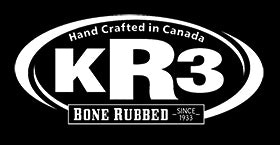
The Early Years
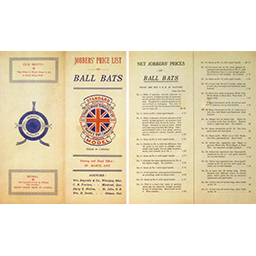
The town of St. Marys Ontario is located on the Thames River about 22 miles from London. It was first settled in 1839 when Thomas Ingersoll a brother of Laura Secord, built a mill at Little Falls for the Canada Company. In 1841-43 he erected a sawmill and grist mill in return for land in the vicinity. These mills formed a nucleus for a settlement called St. Marys and it was not long before other businesses including a flax mill, a blacksmith, a carriage maker, a butter and cheese maker and retail merchants became established in the area. A village was incorporated by 1854. By the year 1868 the merchantile business was well established with Beattie’s General Store among the leading merchants. At this time one of the other large retailers decided to leave for Toronto where he could better pursue his dreams of creating a new system of retailing in Canada. His name was Timothy Eaton who eventually established Canada’s largest department store and catalogue business. Solen Lewis Doolittle born near Aylmer Ontario in 1854 arrived in St. Marys in 1905 and by 1907 was planning to establish a handle and hockey stick factory with the Town Council considering a $6000.00 loan bylaw. The company was incorporated on March 30, 1908 and Mr. Doolittle purchased a site from Weir and Wier on James Street just north of their flax mill. Construction on the building commenced at once and it was opened on June 25, 1908. The plant wasted no time in producing a complete line of hockey sticks and a 1909 price list shows no less than 16 different models including defense, forward, goal, boys, junior and miniature. The trade prices ranged from 45 cents/dozen to $4.05/dozen for goal sticks. By 1910, they were selling sticks as far away as Regina as well as manufacturing axe, pick and hammer handles. A disastrous fire leveled the factory on January 24, 1912 at the height of their business and production ceased over the winter into the spring and summer of 1912, when they took an option on the Weir flax mill which was located near the original plant. By August 29, 1912 they had completed their move and were planning on enlarging it to accommodate the handle, hockey stick and St. Marys baseball bat lines. The business once again resumed at its former pace and results were encouraging enough to announce at the companies annual meeting to be held in St Marys on Feb 13, 1913. By 1915 the all new St. Mary’s Wood Specialty Co. price list carried 16 models of hockey sticks and 27 models of baseball bats. The bats were made of genuine choicest selection of 1st quality, straight-grained, air-seasoned, second growth white ash filled with the best imported ball bat fillers and finished with attractive coloured transfers, sold through a network of agencies set up in Winnipeg, Ottawa, Montreal and St Johns New Brunswick. The 1917 price list called attention to their being the “largest factory in Canada for the manufacture of hockey sticks” Proper wood seasoning, standard patterns, good workmanship, and proper grading had secured for their products a position second to none in the market. Ball bats were put up in 2, 4, 6, 8, 10 and 12 dozen crates for shipping with top models listed at $10.00/dozen. Mr. Doolittle died on Saturday October, 25th 1919 after being sick for a short time with pneumonia. He was 65 years old and left a widow, 3 daughters and a step-son in Montreal. This set back did not affect the operation of the factory which was being capably managed by Mr. Currie who resided at the corner of Ontario and Queen Street. Like all industries, the business felt the bite of the depression with sales tailing off into the early 1930’s. At this time, Seagrams, through their Canada Barrels and Kegs Company purchased the St. Mary’s Wood Specialty Co on July 12, 1933 and the employees and machinery were transferred to their Hespeler Wood Products plant. Some of the key employees were Russell Seaton, Tom Marquis, Bob Noble and Miss Grace Crozier who had joined St. Marys as a young girl. She spent her entire working career at these two plants and retired in 1972 as head of the baseball bat line a significant accomplishment before woman’s equality in the workplace. She was the only woman who worked in the plant for 25 years and added a significant dimension to the Hespeler operation. Special thanks to Brian R. Logie for allowing us to quote from his book “They Shoot, They Score – The Story of a Hockey Stick Manufacturer”
Seagram & Cooper Years
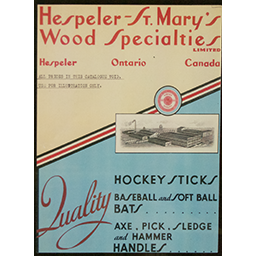
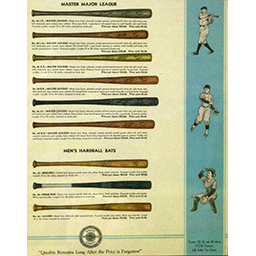
On January 7, 1935 the company changed its name to Hespeler-St.Mary’s Wood Specialties Ltd and its catalogue that year listed 20 hockey sticks models with new names like Mic Mac, Green Flash and Professional. St Mary’s lines included 10 high-grade hickory axe & sledge handles and 29 ball bat models in Professional “Superpower” baseball, softball and boys models. Top baseball bats were now bone rubbed and listed at $3.00 each with new sales agencies now in Vancouver BC. Gaining popularity, by 1938 the company was now known as the “world’s largest hockey stick manufacturers” . The company survived the depression and the outbreak of the war did not slow down business which thrived throughout this period. In 1947 Hespeler celebrated its Old Boys Town Re-Union from June 30 to July 6. An aerial photo of the factory appeared in the program along with a display of the many product lines the plant offered. The caption for the photograph carried the following information “Today this concern is turning out wood items to the tune of over 1,000,000 units per year. Some of its principle products are hickory striking tool handles such as axe, pick, sledge and hammer, the world famous lines of Hespeler hockey sticks and St. Marys baseball and softball bats. These products are shipped all over the world.” During the 1950’s the company phased out the tool products and concentrated on hockey sticks and baseball bats. At this time, with few competitors, Hespeler was considered one of the leaders in the industry celebrating its 50th anniversary in 1958. Sales representatives now included the Maritimes and Newfoundland with foreign representatives in the US, British Isles, Sweden, Holland, Belgium, Switzerland, Australia, New Zealand, South Africa, Mexico and Dominican Republic the bat “models” included Ted Williams, Mickey Mantle, Al Rosen, Eddie Mathews, Duke Snider, and Stan Musial. By 1972 the next chapter in the story was about to unfold. Jack Cooper worked in the personal and travel leather goods department at Eatons in 1928. He bought leather goods from a “transplanted Scot” R.H. Cameron who had founded General Leather Goods in 1905. Jack Cooper had long admired the quality of General’s leather products and expressed a desire to join the company which employed 15 people. He met Mr. Cameron in June 1932 and a week later was hired for $20/week, a dollar more than his previous salary. The company made some ski and snow shoe harness sets but were being affected by the depression. They began to make low priced hockey shin pads from $0.39 to $1.00 per pair, then all leather hockey gloves from $2.00/Pr to $4.00 for the pro models. In 1939 Jack Cooper and Cecil Weeks (a cousin of Mr. Cameron) were running most of the business which they purchased in 1946 when Mr. Cameron was 78 years old. The company became Cooper Weeks and was later famous as Canada’s leading manufacturer of leather protective hockey equipment and baseball gloves. It became Cooper of Canada on June 15, 1971. On July 5, 1972 Cooper purchased Hespeler-St. Mary’s Wood Specialties Ltd from the Seagram family, who still controlled the business through their Waterloo Woods Products Company. The name remained the same as Cooper operated the plant as the Hespeler -St. Mary’s Wood Specialties Division until 1979 when it became a part of Cooper Canada Ltd. Ball bat sales more than tripled over the next 10 years and a small moment in baseball history occurred in September 1985 when Tony Fernandez was the 1st Pro Player to use a Cooper Bat. Unfortunately for Cooper, the league hadn’t approved its use, so Fernandez went back to the dugout for a new bat. On March 27th, 1986 the Cooper bat was accepted by the Major League Playing Rules Committee for use in Major League baseball games. On April 11th, 1986 in a game against world-series champions, Kansas City Royals, Buck Martinez of the Toronto Blue Jays had his first hit of the season off a Cooper bat and this was the 1st Major League hit ever off a Canadian made bat. Tim Raines of the Montreal Expos won the 1986 NL Batting Championship using the newly introduced “Cooper” bat. Paul Molitor was also slamming a Cooper bat during his 39 game hitting streak in 1987. By 1988, after 3 short years, the company had grabbed 30% of the professional bat market. Cooper limited their sales to 130 players and 8500 bats/season, which was their maximum capacity at their Cambridge (Hespeler) plant. They remained #2 behind Louisville. Year after year, more and more major league stars like Kelly Gruber, Jesse Barfield, Cecil Fielder, Joe Carter and others put their faith in Cooper to deliver. By 1995 over 70,000 major league bats had been made for over 850 major league players in the last 10 years. According to Montreal Expos outfielder Hubie Brooks, in an article dated March 1989, “These bats (Cooper) are the best bats in the business. You know why they are so good…it’s the grain. The bats don’t break as often. People are going to be begging you for these bats soon.” In 1996 the Cooper line was discontinued at this plant. The corporate decision to transfer production to another location led to a decline from 130 to less than 5 Pro players in just one year. The Pro ball bat machinery in Cambridge started to gather sawdust drifting gently in from the Pro stick machines still running and gone were the days of watching 12 of 18 starters in a game using Cooper bats. This created the beginning of a vacuum of silence waiting for something to happen….. Special Note: Mr. Cooper or “the Chief” as he was affectionately called by his employees built his success for 55 years on high performance quality products, great service, strong research and development all combined with his personal integrity and dedication to his employees, suppliers and customers. He was elected to the Canadian Business Hall of Fame in 1989 an honor he truly deserved.
The KR3 Years
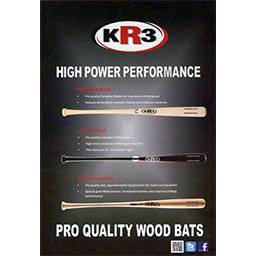
In the spring of 1999, the silence was broken when long time Cooper Plant Manager Ross Huehn decided it was time to dust off the machinery and restart the tradition. Mr. Huehn began working at Cooper on July 19th, 1973 as Shipping & Receiving Supervisor, was promoted to Production Manager in 1974 in charge of inventory control of hockey stocks and baseball bats in 2 Canadian and 1 US warehouse along with production scheduling. He was promoted to Plant Manager in Jan of 1976. The entire Cooper Pro Shop was purchased, lead staff such as Frank Cavanaugh - Ball Bat Lead Hand, (Cooper 1976) and Dave Mather - Maintenance & Pro Bat Smith, (Cooper 1976) and new equipment brought in to a new location in Kitchener, Ontario to begin the process of establishing the 3rd generation in Canadian bat manufacturing from St. Marys to Cooper to KR3. The new KR3 was now under the leadership of Rachel Huehn who began working in September of 1999. She started to re-build for future generations, a Canadian company with vast experience in purchasing high quality wood, grading, turning and finishing bats using ancient hardening processes all with focus on making products that out-perform at the highest professional levels. As KR3 began setting up for production Mr. Huehn continued to work full time as Plant Manager at the Hespeler plant for the current owners Bauer Nike Hockey where hockey sticks have always continued to be manufactured. A special thank you will always exist to Bauer Nike for agreeing to sell the bat portion of the company to Mr. Huehn at fair market value so as to pass on the traditions to the next generation. At the start of the year 2000, KR3 began selling bats to Independent teams in the US and manufacturing for other well-known brand labels. As well as joining with the Canadian Baseball Hall of Fame in St. Marys, becoming their exclusive bat supplier and providing them with all of their Induction Day bats each year. KR3 was approved and received their major league license on Feb 2, 2001 and spent time in 2001 and 2002 sampling and working with major league players, while keeping the doors open for the local players in the area and in doing so quickly noticed that amateur players had no access to good quality wooden bats. So we began offering major league quality to all of our customers and watched these teams begin winning championships. This timing was perfect for us as more and more leagues were moving away from aluminum and back to traditional game being played with wood. In 2003 we signed a deal to become the Official Bat Supplier for the Canadian Baseball League. Supporting growth of baseball in Canada has always been a principle focus for us so we were very interested to get involved. What hasn’t changed since we opened is our business perspective. We will always offer the highest quality baseball bats at good prices and excellent service to every baseball player. A true Pro Shop for all ball players. KR3 was approved for MLB play on January 11, 2011. For the next 3 years focus was on sales of Pro Quality solid wood bats. In 2014, we decided to expand our Pro Quality solid wood bats to every ball player and to grow our Wood Composite line worldwide. Many nights and weekends have been consumed by our family finishing bats sometimes around the clock. “No matter how time goes by, I will always remember the many weekends when we first began, that I spent dipping bats well into the night alongside my father. He is a dedicated honest hardworking businessman and I have learned a lot about the old-fashioned business values that are diminishing in today’s marketplace. KR3 will always be managed by these values.” says Rachel Hamel. “Our customers return every season knowing that we will always do whatever we can for them.” There is an amazing difference between pro grade wood and retail grade wood and it shows its effects in the game. Bringing back the “Pop” when a player hits with a KR3 Pro wood bat brings back the fun as he rounds the bases for home. It’s summertime, BBQ’s and good weather with an old game played the way it was meant to be played.
High Performance Bats that Give you the Freedom to Hit Outside the Sweet Spot Without Breaking your Bat. The Ultimate in High Performance.
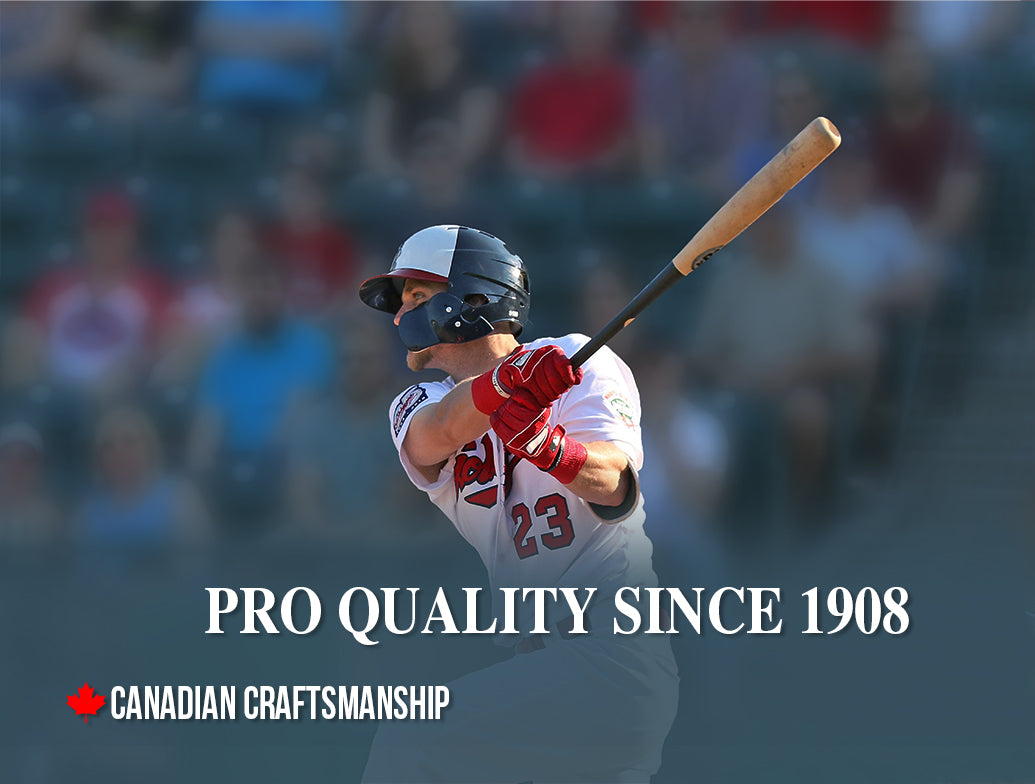
2003 - Launch Maple Magnum With 90 Day Warranty and BBCOR
2004 - Launch Hickory Magnum with 6 month warranty and BBCOR The Hardest Wood in Baseball
2007 - Launch Maple Fibre-Loc with 90 Day Warranty and BBCOR
2010 - Launch Birch Crossover in Drop 5 With 90 Day Warranty
2012 - Launch Eagle Magnum with 60 Day Warranty and BBCOR “Designed by President with 40 years of bat making”
2016 - Launch Birch Crossover in Drop 7 With 90 Day Warranty and BBCOR
2017 - Launch Eagle Magnum Ultra with 90 Day Warranty and BBCOR. Also Launch Maple Crossover with 90 Day Warranty.
2019 - Launch Maple Magnum Ultra with 4 Month Warranty and BBCOR
2020 - Launch Maple Magnum with 6 Month Warranty and BBCOR. Launch Maple Magnum Ultra Gold Series with 1 Year Warranty and BBCOR
